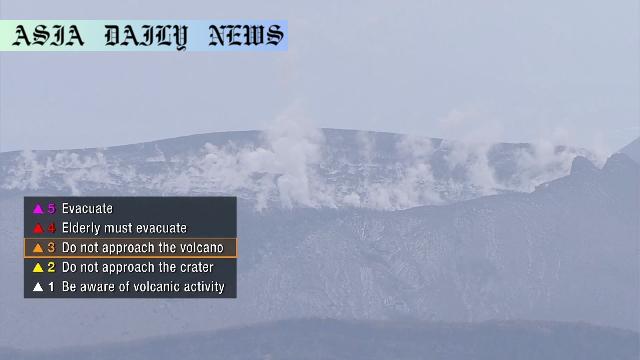Volcanic Alert: Officials raised the alert level for Japan’s Mount Shinmoe to Level 3 due to increasing volcanic activity and risks.

Volcanic Activity Surges at Mount Shinmoe
Mount Shinmoe, part of the Kirishima mountain range located on the border of Kagoshima and Miyazaki prefectures in Japan, has shown heightened volcanic activity, leading officials to raise its alert level to Level 3 on a five-level scale. This significant development comes as the Japan Meteorological Agency (JMA) observed an increase in volcanic earthquakes directly beneath the crater starting Friday. This escalation indicates a rising likelihood of an eruption, prompting authorities to impose restrictions to access the mountain and its surrounding areas. At 3:53 a.m. on Sunday, this decision was officially enacted following the detection of further alarming geological developments.
Satellite observations since November last year have revealed that the ground under and around Mount Shinmoe has been expanding. Early on Sunday, an especially concerning set of events unfolded, including ground swelling and volcanic tremors that persisted for approximately 10 minutes. Together, these indicators strongly suggest that magma activity is increasing within the mountain, further substantiating the upgraded alert level.
Public Safety Concerns Amid Eruption Threat
With the volcano’s activity rising, the JMA has issued clear warnings regarding potential hazards. If an eruption occurs, large volcanic rocks could fly as far as 4 kilometers from the crater, while pyroclastic flows, consisting of scorching gases and debris, could extend up to 2 kilometers. Residents and travelers are urged to steer clear of the dangerous zones and adhere to safety protocols. Officials have also highlighted the possibility of ashfall and smaller rocks being carried by strong winds and landing far from the volcano, posing risks to remote areas.
Moreover, explosive eruptions could generate powerful air vibrations capable of damaging property. During the 2011 eruption of Mount Shinmoe, such vibrations shattered windows, causing injuries. In light of these risks, authorities encourage individuals to keep away from windows near the mountainside, draw curtains to minimize potential harm, and monitor alerts meticulously. The potential impact on drivers, especially those traveling downwind of the mountain, is another area of concern, with ash possibly reducing visibility and damaging vehicles.
Steps Forward: Expertise and Preparedness
In response to the situation, a news conference was held at 6 a.m. on Sunday. During the conference, Kanno Tomoyuki, an official overseeing volcanic monitoring, reiterated the importance of residents following all municipal instructions. He emphasized that the 2011 eruption served as a somber reminder of the type of explosive activity Mount Shinmoe is capable of. The government and local agencies are maintaining a close watch on the volcanic activity, utilizing advanced satellite data and ground-level observations to track any further signs of escalation.
Preparedness is now the key priority for residents living in regions near Mount Shinmoe. Public awareness campaigns are being rolled out to inform locals about safety measures, such as evacuation routes and proper precautions for ashfall. Authorities are also providing updates via multiple channels to ensure widespread dissemination of critical information. Scientists are advocating for a proactive approach to ensure that any sudden developments can be met with swift action to protect lives and property.
Commentary
Understanding the Implications of a Volcanic Alert
Mount Shinmoe’s increased activity is a stark reminder of the powerful forces of nature that lie beneath the surface of our planet. This sudden surge in seismic and geological activity not only underscores the unpredictability of volcanic eruptions but also highlights the importance of staying prepared in regions prone to such natural events. The decision to raise the alert level to Level 3 reflects a careful assessment of the risks, and it is commendable that Japanese authorities are taking proactive measures to safeguard residents and visitors.
One striking aspect of this situation is the use of advanced technology, such as satellite data, to monitor volcanic movements. This capability has allowed scientists to detect the minute changes in ground expansion and provide timely alerts to the public. However, technology alone cannot mitigate the risks; it must be complemented by public awareness, adherence to safety protocols, and collaboration between local governments and communities.
As we reflect on this event, it serves as a powerful opportunity for education about volcanic hazards and preparedness. Such natural occurrences remind us of the delicate balance between humanity and nature, urging us to respect and adapt to the environment rather than attempting to control it. Preparedness will not only help save lives but also reduce the long-term socio-economic impact these events can have on affected regions.
Global Lessons and Takeaways
The developments at Mount Shinmoe also carry lessons for the global community. In a time when climate change and natural disasters are becoming increasingly interconnected, it is crucial to invest in monitoring systems capable of predicting environmental shifts. International collaborations between scientific communities may further enhance the accuracy of such forecasts, paving the way for a safer, more informed world.


